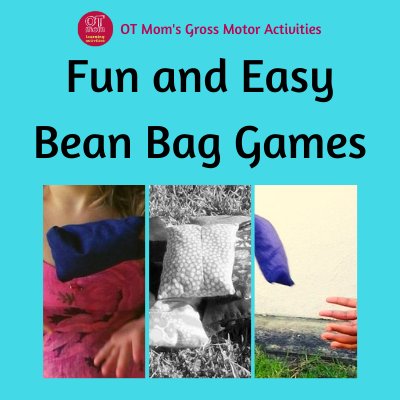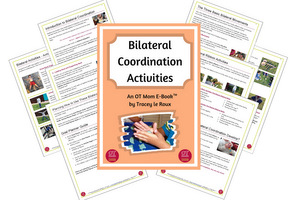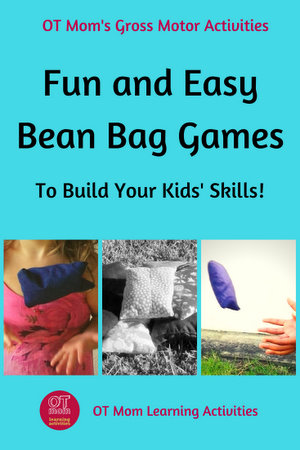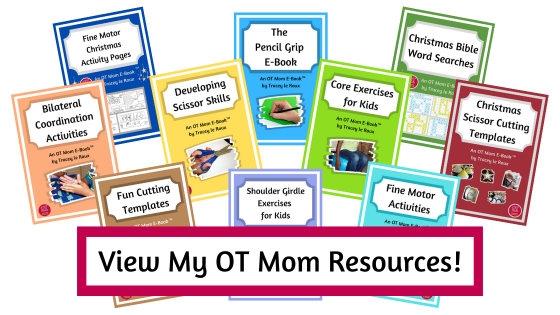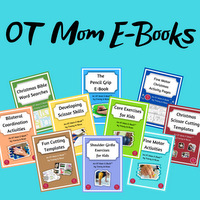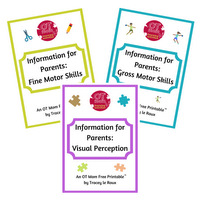- Home Page
- Gross Motor Activities
- Bean Bag Games for Kids
Bean Bag Games for Kids
Develop Gross Motor Skills!
These simple bean bag games for kids are a fantastic way to develop gross motor skills through play. These fun indoor activities can get your young kids moving - great for home, school and even as kids' party games!
Bean bags are a perfect toy for young kids or for those who struggle with coordination skills. They are easier to handle than a ball, because they don't roll away - which means less frustration and more success!
For your convenience, I may link to products that are similar to the ones I use. I may receive a small commission if you purchase a product through my links, at no additional cost to you. Thank you for supporting my site!
Bean Bag Balance Challenge
Have your child balance a bean bag on the head while walking along a balance beam, a length of rope, or along a line of masking tape on the floor.
Extra Challenge: ask your child to keep the bean bag on the head while:
- doing a heel-toe walk (tightrope walking!)
- walking around obstacles
- squatting down to touch an object on the ground and standing back up
Age Guide: Good for ages 4- 8. Younger children can start by just walking on the line; older children can try the more complex challenges.
 Balancing with a bean bag
Balancing with a bean bagPro Tip: This activity helps build core stability! To keep the bean bag from falling, your child has to engage their core muscles, which is important for all gross motor activities.
Coordination Games: Toss, Catch and Relay
1) Bean Bag Toss and Catch
Tossing and catching a bean bag develops hand-eye coordination. It is much easier for kids to do this with a bean bag than with a ball, as bean bags don't roll away.
- Show your child how to toss a bean bag gently into the air and then catch again with both hands. Preschool children (age 3-4) can do a very gentle toss, older kids can toss just above head level.
- Extra Challenge: Can they clap once before catching? How about two claps? Can they try a one-handed catch?
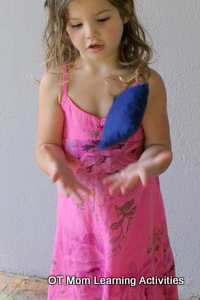 Preschool child
Preschool child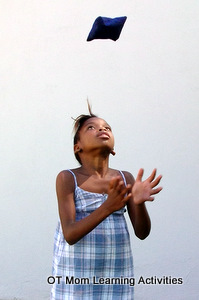 Older child
Older child- You can also have two children toss the bean bag to each other.
Start with them standing close together and have them take a step back each time they successfully complete a catch.
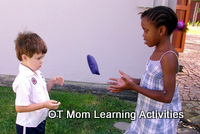 Tossing and catching with a partner
Tossing and catching with a partnerPro Tip: Encourage your child to keep their eyes on the bean bag the entire time, from the moment it leaves their hands until they catch it again. This is called visual tracking, and it's a key part of hand-eye coordination.
2) Bean Bag Relay
Relays are great bean bag games for kids in small groups - whether PE classes or playdates.
You will need: a few kids, an empty bucket and a pile of bean bags (at least as many bean bags as kids)
-
Have the kids stand in a line, one behind the
other.
- Put a pile of beanbags in front of the first child, and an empty bucket behind the last child.
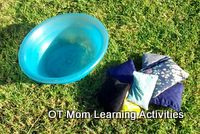 Supplies for relay game
Supplies for relay game- The first child grabs a bean bag and passes it overhead to the child behind them. This continues down the line.
- The last child pops it in the bucket, and then runs to the front to start again.
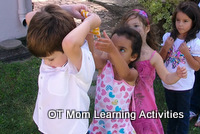 Relay game with bean bags
Relay game with bean bagsExtra Challenge: You can also have the kids pass the bean bag under their legs, or alternate passing overhead and then under their legs.
Age Guide: Best for ages 4 and up, as it requires cooperation!
Pro Tip: This bean bag game is great for bilateral coordination (using both hands together) and also for spatial awareness.
Crossing The Midline With Bean Bags
Crossing the midline - the imaginary line that divides the body into left and right sides - is an important part of your child's development.
You can use these bean bag activities to help your kids cross the midline in a natural way.
Pro Tip:
Have the children sit on their knees as pictured, or with legs crossed.
This stabilizes the lower body so the trunk can rotate to enable midline crossing.
1) Pass The Bean Bag
Lovely bean bag games for kids' parties or small groups.
- Have the children sit in a line, next to each other
- Have them pass the bean bags, objects or parcels down the line using both hands to cross the midline as shown.
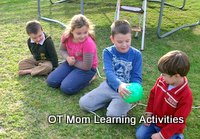 Crossing the midline with a relay
Crossing the midline with a relay2) Target Toss
The idea is to have your child throw a bean bag across their midline to a target, from a seated position.
- Place the target (a laundry basket, hula hoop or corn-hole board) on their left side.
- Have your child use the RIGHT hand to pick up a bean bag and throw it at the target on their LEFT side.
- Switch sides! Have your child use the LEFT hand to throw at a target on their RIGHT side.
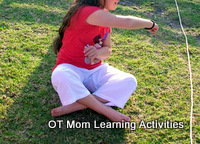 Tossing a bean bag across the midline
Tossing a bean bag across the midlineAge Guide: Preschool kids can use simpler targets like simply hitting a wall or getting the bean bag over a line. Older kids can use specific targets like the hula hoop or corn-hole board.
Pro Tip: Watch your child's torso. The goal is for your child to rotate the trunk to throw, rather than shifting the whole body to face the target. That rotation is where the real midline-crossing magic happens!
The Bean Bag Endurance Challenge
Bean bag games can help your child improve their physical endurance!
A boring exercise can seem more fun when there is something to carry from one place to another.And it is even more exciting if there are two or more kids racing to see who can finish first!
- Place a pile of beanbags at one side of the yard/room and an empty bucket at the other.
- The challenge is for your child to move all the bean bags to the bucket, one by one.
- They can run, hop on one foot, jump with two feet, crawl or skip to take the bean bag to the bucket.
Extra Challenge: carry the bean bag on an outstretched arm, or on a large spoon!
Age Guide: Great for all ages, and can be done as a family!
Pro Tip: This is a great activity to practice pacing. Encourage them to keep a steady speed rather than running out of breath on the first two trips.
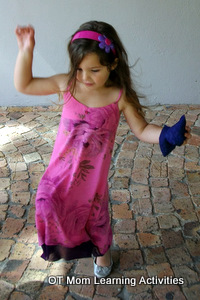 Hopping while holding a bean bag
Hopping while holding a bean bagHow To Make Easy Homemade Bean Bags
You don't need to buy fancy equipment! You can easily make your own bean bags at home.
1) Simple Sewn Bean Bags
- Cut two identical squares of scrap fabric (about 4x4 inches)
- With the outside faces together, sew around 3 of the sides
- Turn the pouch right side out, half fill with dried beans, rice or corn, then securely sew the final side closed. Use fabric scraps for a lighter stuffing.
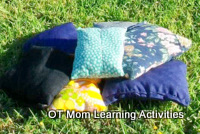 Homemade bean bags
Homemade bean bags2) The 2-Minute No-Sew Sock Bean Bag
This is my favorite bean bag trick! Take all those lonely socks without a match, and put them to good use!
- Take one sock and half fill it with other lonely socks
- Tie a tight knot in the sock above the filling.
- If the sock is long enough, pull the loose end over the stuffed section to neaten it
That's it! You have a wonderful "tossing blob" ready for your games.
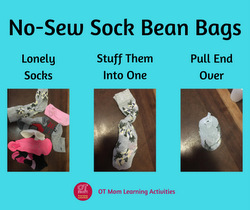
If you do prefer to buy, Amazon stock a wide range of bean bags#Ad, but be sure to check the reviews to get the size and weight and quality that you want.
Did Your Child Struggle With These Bean Bag Activities?
If your child struggled with these bean bag games, don't worry! It's a great clue about which skill could use a little more practice. You can use other, fun gross motor activities to build your child's confidence.
Visit the pages below to get free activity ideas to help with specific gross motor skills:
- Simple core exercises to help with balance
- Bilateral coordination activities to help with using both hands together
- Hand-eye coordination activities
- Midline crossing activities and tips
If you want to help your child use both sides of their body more effectively, then check out my comprehensive resource full of Bilateral Coordination Activities!
You will receive more than 50 pages of guidance and activities designed to help your child develop this important skill!
FAQ About Bean Bag Games for Kids
What skills do bean bag games develop?
What skills do bean bag games develop?
Bean bag games for kids are great for developing a wide range of gross motor skills, including hand-eye coordination, balance, core stability, bilateral coordination (using both hands together), and crossing the midline.
What can I use as a substitute for bean bags?
What can I use as a substitute for bean bags?
If you don't have bean bags, you can use rolled-up pairs of socks, or small stuffed animals. The goal is to have something that is easy to grip and doesn't roll away.
Try the no-sew bean bag option I suggest above, that uses lonely socks!
Are bean bag activities good for toddlers?
Are bean bag activities good for toddlers?
Yes, with supervision (owing to the small beans/corn inside the bean bags).
Simple, repetitive activities like picking up bean bags and putting them in a bucket or basket, are very satisfying for toddlers. The no-sew sock bean bags are great for this age group.
You can also use bean bags to reinforce color recognition and spatial awareness with this age group - "put the bean bag UNDER the chair, ON TOP OF the table" etc.
The advice and learning activities on this website are NOT a replacement for evaluation and treatment by an occupational therapist. If you suspect your child has any kind of delays, please seek a professional opinion and read my disclaimer before proceeding.
Thank you for visiting my site - I hope you feel inspired and ready to play!
Please do share with other parents, caregivers or teachers you think will benefit!
- Home Page
- Gross Motor Activities
- Bean Bag Games for Kids
Share this page to help others!
Didn't find what you were looking for? Try a search of my site!
